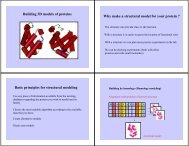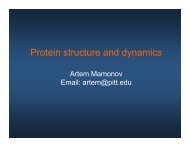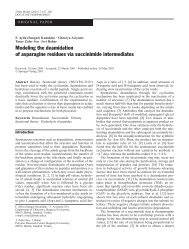ProDy: Protein Dynamics Inferred from Theory and Experiments
ProDy: Protein Dynamics Inferred from Theory and Experiments
ProDy: Protein Dynamics Inferred from Theory and Experiments
You also want an ePaper? Increase the reach of your titles
YUMPU automatically turns print PDFs into web optimized ePapers that Google loves.
Bioinformatics Advance Access published April 5, 2011<br />
<strong>ProDy</strong>: <strong>Protein</strong> <strong>Dynamics</strong> <strong>Inferred</strong> <strong>from</strong> <strong>Theory</strong> <strong>and</strong> <strong>Experiments</strong><br />
Ahmet Bakan * , Lidio M. Meireles <strong>and</strong> Ivet Bahar *<br />
Department of Computational <strong>and</strong> Systems Biology, <strong>and</strong> Clinical & Translational Science Institute, School of Medicine,<br />
University of Pittsburgh, 3064 BST3, 3501 Fifth Ave, Pittsburgh, PA 15213<br />
Associate Editor: Prof. Anna Tramontano<br />
ABSTRACT<br />
Summary: We developed a Python package, <strong>ProDy</strong>, for structurebased<br />
analysis of protein dynamics. <strong>ProDy</strong> allows for quantitative<br />
characterization of structural variations in heterogeneous datasets of<br />
structures experimentally resolved for a given biomolecular system,<br />
<strong>and</strong> for comparison of these variations with the theoretically predicted<br />
equilibrium dynamics. Datasets include structural ensembles<br />
for a given family or subfamily of proteins, their mutants <strong>and</strong> sequence<br />
homologues, in the presence/absence of their substrates,<br />
lig<strong>and</strong>s or inhibitors. Numerous helper functions enable comparative<br />
analysis of experimental <strong>and</strong> theoretical data, <strong>and</strong> visualization of<br />
the principal changes in conformations that are accessible in different<br />
functional states. <strong>ProDy</strong> API has been designed so that users<br />
can easily extend the software <strong>and</strong> implement new methods.<br />
Availability: <strong>ProDy</strong> is open-source <strong>and</strong> freely available under GNU<br />
General Public License <strong>from</strong> http://www.csb.pitt.edu/<strong>ProDy</strong>/.<br />
1 INTRODUCTION<br />
<strong>Protein</strong> dynamics plays a key role in a wide range of molecular<br />
events in the cell, including substrate/lig<strong>and</strong> recognition, binding,<br />
allosteric signaling, <strong>and</strong> transport. For a number of well-studied<br />
proteins, the <strong>Protein</strong> Data Bank (PDB) hosts multiple highresolution<br />
structures. Typical examples are drug targets resolved in<br />
the presence of different inhibitors. These ensembles of structures<br />
convey information on the structural changes that are physically<br />
accessible to the protein, <strong>and</strong> the delineation of these structural<br />
variations provides insights into structural mechanisms of biological<br />
activity (Yang et al., 2008; Bakan & Bahar, 2009).<br />
Existing computational tools <strong>and</strong> servers for characterizing protein<br />
dynamics are suitable for single structures (e.g., Anisotropic<br />
Network Model (ANM) server (Eyal et al., 2006), elNémo (Suhre<br />
& Sanejou<strong>and</strong>, 2004), FlexServ (Camps et al., 2009)), pairs of<br />
structures (e.g., open <strong>and</strong> closed forms of enzymes; MolMovDB<br />
(Gerstein & Krebs, 1998)), or NMR models (e.g., PCA_NEST<br />
(Yang et al., 2009)). Tools for systematic retrieval <strong>and</strong> analyses of<br />
ensembles of structures are not publicly accessible. Ensembles<br />
include X-ray structures for a given protein <strong>and</strong> its complexes;<br />
families <strong>and</strong> subfamilies of proteins that belong to particular structural<br />
folds; or a protein <strong>and</strong> its mutants resolved in the presence of<br />
different inhibitors, lig<strong>and</strong>s or substrates. The analysis of structural<br />
variability in these ensembles could open the way to gain insights<br />
into rearrangements selected/stabilized in different functional<br />
states (Bahar et al., 2010; Bahar et al., 2007), or into the structure-<br />
*<br />
To whom correspondence should be addressed.<br />
encoded dynamic features shared by protein family or subfamily<br />
members (Velazquez-Muriel et al., 2009; Raimondi et al., 2010;<br />
Marcos et al., 2010). The lack of software for performing such<br />
operations is primarily due to the non-uniform content of structural<br />
datasets such as sequence variations at particular regions, including<br />
missing or substituted residues, short segments or loops. We developed<br />
<strong>ProDy</strong> to analyze <strong>and</strong> retrieve biologically significant<br />
information <strong>from</strong> such heterogeneous structural datasets. <strong>ProDy</strong><br />
delivers information on the structural variability of target systems<br />
<strong>and</strong> allows for systematic comparison with the intrinsic dynamics<br />
predicted by theoretical models <strong>and</strong> methods, thus helping gain<br />
insight into the relation between structure, dynamics <strong>and</strong> function.<br />
2 DESCRIPTION AND FUNCTIONALITY<br />
2.1 Input for <strong>ProDy</strong><br />
The input for <strong>ProDy</strong> is the set of atomic coordinates in PDB format<br />
for the protein of interest, or simply the PDB id or sequence of the<br />
protein. Given a query protein, fast <strong>and</strong> flexible <strong>ProDy</strong> parsers are<br />
used to Blast search the PDB, retrieve the corresponding files (e.g.,<br />
mutants, complexes, or sequence homologues with user-defined<br />
minimal sequence identity) <strong>from</strong> the PDB FTP server <strong>and</strong> extract<br />
their coordinates <strong>and</strong> other relevant data. Additionally, the program<br />
can be used to analyze a series of conformers <strong>from</strong> molecular dynamics<br />
(MD) trajectories inputted in PDB file format or programmatically<br />
through Python NumPy arrays. More information on the<br />
input format is given at the <strong>ProDy</strong> website tutorial <strong>and</strong> examples.<br />
2.2 <strong>Protein</strong> ‘dynamics’ <strong>from</strong> experiments<br />
The experimental data refer to ensembles of structures, X-ray crystallographic<br />
or NMR. These are usually heterogeneous datasets, in<br />
the sense that they have disparate coordinate data arising <strong>from</strong><br />
sequence dissimilarities, insertions/deletions, or missing data due<br />
to unresolved disordered regions. In <strong>ProDy</strong>, we implemented algorithms<br />
for optimal alignment of such heterogeneous datasets <strong>and</strong><br />
building corresponding covariance matrices. Covariance matrices<br />
describe the mean-square deviations in atomic coordinates <strong>from</strong><br />
their mean position (diagonal elements) or the correlations between<br />
their pairwise fluctuations (off-diagonal elements). The principal<br />
modes of structural variation are determined upon principal component<br />
analysis (PCA) of the covariance matrix, as described previously<br />
(Bakan & Bahar, 2009).<br />
Downloaded <strong>from</strong> bioinformatics.oxfordjournals.org by guest on April 7, 2011<br />
© The Author(s) 2011. Published by Oxford University Press.<br />
This is an Open Access article distributed under the terms of the Creative Commons Attribution Non-Commercial License (http://creativecommons.org/licenses/<br />
by-nc/2.5/uk/) which permits unrestricted non-commercial use, distribution, <strong>and</strong> reproduction in any medium, provided the original work is properly cited.<br />
1
2.3 <strong>Protein</strong> dynamics <strong>from</strong> theory <strong>and</strong> simulations<br />
We have implemented classes for Gaussian network model (GNM)<br />
analysis <strong>and</strong> for normal mode analysis (NMA) of a given structure<br />
using the anisotropic network model (ANM) (Eyal et al., 2006).<br />
Both models have been widely used in recent years for analyzing<br />
<strong>and</strong> visualizing biomolecular systems dynamics (Bahar et al.,<br />
2010). The implementation is generic <strong>and</strong> flexible. The user can (i)<br />
build the models for any set of atoms, e.g., the substrate or inhibitor<br />
can be explicitly included to study the perturbing effect of binding<br />
on dynamics, <strong>and</strong> (ii) utilize user-defined or built-in distancedependent<br />
or residue-specific force constants (Hinsen et al., 2000;<br />
Kovacs et al., 2004). <strong>ProDy</strong> also offers the option to perform essential<br />
dynamics analysis (EDA) (Amadei et al., 1993) of MD<br />
snapshots, which is equivalent to the singular value decomposition<br />
of trajectories to extract principal variations (Velazquez-Muriel et<br />
al., 2009).<br />
2.4 <strong>Dynamics</strong> analysis example<br />
Figure 1 illustrates the outputs generated by <strong>ProDy</strong> in a comparative<br />
analysis of experimental <strong>and</strong> computational data for p38 kinase<br />
(Bakan & Bahar, 2011). Panel A displays the dataset of 150<br />
X-ray crystallographically resolved p38 structures retrieved <strong>from</strong><br />
the PDB <strong>and</strong> optimally overlaid by <strong>ProDy</strong>. The ensemble contains<br />
the apo <strong>and</strong> inhibitor-bound forms of p38, thus providing information<br />
on the conformational space sampled by p38 upon inhibitor<br />
binding. Parsing structures, building <strong>and</strong> diagonalizing the covariance<br />
matrix to determine the principal modes of structural variations<br />
takes only 38 seconds on Intel CPU at 3.20 GHz. Panel C<br />
illustrate the first principal mode of structural variation (PC1; violet<br />
arrows) based exclusively on experimental structural dataset for<br />
p38.<br />
As to generating computational data, two approaches are taken<br />
in <strong>ProDy</strong>: NMA of a representative structure using its ANM representation<br />
(panel B; color-coded such that red/blue regions refer to<br />
largest/smallest conformational mobilities); <strong>and</strong> EDA of MD trajectories<br />
provided that an ensemble of snapshots is provided by the<br />
user. The green arrows in panel C describe the first (lowest frequency,<br />
most collective) mode predicted by the ANM, shortly<br />
designated as ANM1. The heatmap in panel D shows the overlap<br />
(Marques & Sanejou<strong>and</strong>, 1995) between top-ranking PCA <strong>and</strong><br />
ANM modes. The cumulative overlap between the top three pairs<br />
of modes is 0.73.<br />
An important aspect of <strong>ProDy</strong> is the sampling of a representative<br />
set of conformers consistent with experiments - a feature expected<br />
to find wide utility in flexible docking <strong>and</strong> structure refinement.<br />
Panel E displays the conformational space sampled by experimental<br />
structures (blue dots), projected onto the subspace spanned by<br />
the top three PCA directions, which accounts for 59% of the experimentally<br />
observed structural variance. The conformations generated<br />
using the softest modes ANM1-ANM3 predicted to be intrinsically<br />
accessible to p38 in the apo form, are shown by the red<br />
dots. The sizes of the motions along these modes obey a Gaussian<br />
distribution with variance scaling with the inverse square-root of<br />
the corresponding eigenvalues. ANM conformers cover a subspace<br />
(green ellipsoidal envelope) that encloses all experimental structures.<br />
Detailed information on how to generate such plots <strong>and</strong> figures<br />
using <strong>ProDy</strong> is given in the online documentation, along with<br />
several examples of downloadable scripts.<br />
2.5 Graphical Interface<br />
We have designed a graphical interface, NMWiz, to enable users to<br />
perform ANM <strong>and</strong> PCA calculations <strong>from</strong> within a molecular visualization<br />
program. NMWiz is designed as a VMD (Humphrey et<br />
al., 1996) plugin, <strong>and</strong> is distributed within the <strong>ProDy</strong> installation<br />
package. It is used to do calculations for molecules loaded into<br />
VMD; <strong>and</strong> results are visualized on the fly. The plug-in allows for<br />
depicting color-coded network models <strong>and</strong> normal mode directions<br />
(Fig. 1B-C), displaying animations of various PCA <strong>and</strong> ANM<br />
modes, generating trajectories, <strong>and</strong> plotting square fluctuations.<br />
Downloaded <strong>from</strong> bioinformatics.oxfordjournals.org by guest on April 7, 2011<br />
Fig. 1. Comparative analysis of p38 dynamics <strong>from</strong> experiments (PCA)<br />
<strong>and</strong> theory (ANM). A. Overlay of 150 p38 X-ray structures using <strong>ProDy</strong>.<br />
An inhibitor is shown in space-filling representation. B. Network model<br />
(ANM) representation of p38 (generated using NMWiz <strong>and</strong> VMD). C.<br />
Comparison of the principal mode PC1 (<strong>from</strong> experiments; violet arrows)<br />
<strong>and</strong> the softest mode ANM1 <strong>from</strong> theory (green arrows) <strong>and</strong> (D) overlap of<br />
the top five modes. E. Distribution of X-ray structures (blue) <strong>and</strong> ANMgenerated<br />
conformers (red) in the subspace spanned by PC1-3. The green<br />
ellipsoid is an analytical solution predicted by the ANM.<br />
2.6 Supporting features<br />
<strong>ProDy</strong> comes with a growing library of functions to facilitate comparative<br />
analysis. Examples are functions to calculate, print <strong>and</strong><br />
plot the overlaps between experiment, theory, <strong>and</strong> computations<br />
(Fig 1D) or to view the spatial dispersion of conformers (Fig 1E).<br />
For rapid <strong>and</strong> flexible analysis of large numbers of PDB structures,<br />
we designed a fast PDB parser. The parser can h<strong>and</strong>le alternate<br />
locations <strong>and</strong> multiple models, <strong>and</strong> read specified chains or<br />
atom subsets selected by the user. We evaluated the performance<br />
of <strong>ProDy</strong> relative to Biopython PDB module (Hamelryck & M<strong>and</strong>erick,<br />
2003) using 4701 PDB structures listed in the PDB<br />
SELECT dataset (Hobohm & S<strong>and</strong>er, 1994): we timed parsers for<br />
reading the PDB files <strong>and</strong> returning C α -coordinates to the user (see<br />
documentation). The Python st<strong>and</strong>ard Biopython PDB parser eva-
luated the dataset in 52 minutes; <strong>and</strong> <strong>ProDy</strong> in 11 minutes. In addition,<br />
we implemented an atom selector for rapid access to subsets<br />
of atoms in PDB files. This feature reduces the user programming<br />
effort to access any set of atoms down to a single line of code <strong>from</strong><br />
several lines composed of nested loops <strong>and</strong> comparisons required<br />
with the current Python packages for h<strong>and</strong>ling PDB data. The implementation<br />
of atom selections follows that in VMD. Full list of<br />
selection keywords <strong>and</strong> usage examples are provided in the documentation.<br />
<strong>ProDy</strong> also offers functions for structural alignment <strong>and</strong><br />
comparison of multiple chains.<br />
3 DISCUSSION<br />
Several web servers have been developed for characterizing protein<br />
dynamics, including elNémo (Suhre & Sanejou<strong>and</strong>, 2004),<br />
ANM (Eyal et al., 2006), <strong>and</strong> FlexServ (Camps et al., 2009). These<br />
servers perform coarse-grained ENM based NMA calculations, <strong>and</strong><br />
as such are useful for elucidating structure-encoded dynamics of<br />
proteins. FlexServ also offers the option to use distance-dependent<br />
force constants (Kovacs et al., 2004), in addition to protocols for<br />
coarse-grained generation <strong>and</strong> PCA of trajectories. <strong>ProDy</strong> differs<br />
<strong>from</strong> these as it allows for systematic retrieval <strong>and</strong> comparative<br />
analysis of ensembles of heterogeneous structural datasets. Such<br />
datasets includes structural data collected for members of a protein<br />
family in complex with different substrates/inhibitors. <strong>ProDy</strong> further<br />
allows for the quantitative comparison of the results <strong>from</strong><br />
experimental datasets with theoretically predicted conformational<br />
dynamics. In addition, <strong>ProDy</strong> offers the following advantages: (i)<br />
it is extensible, interoperable, <strong>and</strong> suitable for use as a toolkit for<br />
developing new software, (ii) it provides scripts for automated<br />
tasks <strong>and</strong> batch analyses of large datasets, (iii) it has a flexible API<br />
suitable for testing new methods <strong>and</strong> hypotheses, <strong>and</strong> benchmarking<br />
them against existing methods with minimal effort <strong>and</strong> without<br />
the need to modify the source code, (iv) it allows for producing<br />
publication quality figures when used with Python plotting library<br />
Matplotlib; <strong>and</strong> (v) it provides the option to input user-defined<br />
distance-dependent force function or utilize elaborate classes that<br />
return force constants based on the type <strong>and</strong> properties of interacting<br />
residues (e.g., based on their secondary structure or sequence<br />
separation (Lezon & Bahar, 2010)).<br />
4 CONCLUSION<br />
<strong>ProDy</strong> is a free, versatile, easy-to-use <strong>and</strong> powerful tool for inferring<br />
protein dynamics <strong>from</strong> both experiments (i.e. PCA of ensembles<br />
of structures) <strong>and</strong> theory (i.e. GNM, ANM <strong>and</strong> EDA of MD<br />
snapshots). <strong>ProDy</strong> complements existing tools by allowing the<br />
systematic retrieval <strong>and</strong> analysis of heterogeneous experimental<br />
datasets, leveraging on the wealth of structural data deposited in<br />
the PDB to gain insights into structure-encoded dynamics. In addition,<br />
<strong>ProDy</strong> allows for comparison of the results <strong>from</strong> experimental<br />
datasets with theoretically predicted conformational dynamics.<br />
Finally, through a flexible Python-based API, <strong>ProDy</strong> can be used<br />
to quickly test <strong>and</strong> implement new methods <strong>and</strong> ideas, thus lowering<br />
the technical barriers to apply such methods in more complex<br />
computational analyses.<br />
ACKNOWLEDGEMENTS<br />
Funding: Support <strong>from</strong> NIH 1R01GM086238-01 is acknowledged by IB.<br />
REFERENCES<br />
Amadei, A. et al. (1993) Essential dynamics of proteins. <strong>Protein</strong>s, 17, 412-425.<br />
Bahar, I. et al. (2007) Intrinsic dynamics of enzymes in the unbound state <strong>and</strong> relation<br />
to allosteric regulation. Curr.Opin.Struct Biol, 17, 633-640.<br />
Bahar, I. et al. (2010) Normal mode analysis of biomolecular structures: functional<br />
mechanisms of membrane proteins. Chem.Rev., 110, 1463-1497.<br />
Bakan, A. <strong>and</strong> Bahar, I. (2011) Computational Generation of Inhibitor-Bound Conformers<br />
of p38 MAP Kinase <strong>and</strong> Comparison with <strong>Experiments</strong>. Pacific Symposium<br />
on Biocomputing, 16, 181-192.<br />
Bakan, A. <strong>and</strong> Bahar, I. (2009) The intrinsic dynamics of enzymes plays a dominant<br />
role in determining the structural changes induced upon inhibitor binding.<br />
Proc.Natl.Acad.Sci.U.S.A, 106, 14349-14354.<br />
Camps, J. et al. (2009) FlexServ: an integrated tool for the analysis of protein flexibility.<br />
Bioinformatics, 25, 1709-1710.<br />
Eyal, E. et al. (2006) Anisotropic network model: systematic evaluation <strong>and</strong> a new<br />
web interface. Bioinformatics, 22, 2619-2627.<br />
Gerstein, M. <strong>and</strong> Krebs, W. (1998) A database of macromolecular motions. Nucleic<br />
Acids Res., 26, 4280-4290.<br />
Hamelryck, T. <strong>and</strong> M<strong>and</strong>erick, B. (2003) PDB file parser <strong>and</strong> structure class implemented<br />
in Python. Bioinformatics, 19, 2308-2310.<br />
Hinsen, K. et al. (2000) Harmonicity in slow protein dynamics. Chem.Phys., 261, 25-<br />
37.<br />
Hobohm, U. <strong>and</strong> S<strong>and</strong>er, C. (1994) Enlarged representative set of protein structures.<br />
<strong>Protein</strong> Sci., 3, 522-524.<br />
Humphrey, W. et al. (1996) VMD: visual molecular dynamics. J Mol.Graph., 14, 33-<br />
38.<br />
Kovacs, J. A. et al. (2004) Predictions of protein flexibility: first-order measures.<br />
<strong>Protein</strong>s, 56, 661-668.<br />
Lezon, T. R. <strong>and</strong> Bahar, I. (2010) Using entropy maximization to underst<strong>and</strong> the<br />
determinants of structural dynamics beyond native contact topology.<br />
PLoS.Comput.Biol., 6, e1000816.<br />
Marcos, E. et al. (2010) On the conservation of the slow conformational dynamics<br />
within the amino acid kinase family: NAGK the paradigm. PLoS.Comput Biol, 6,<br />
e1000738.<br />
Marques, O. <strong>and</strong> Sanejou<strong>and</strong>, Y. H. (1995) Hinge-bending motion in citrate synthase<br />
arising <strong>from</strong> normal mode calculations. <strong>Protein</strong>s, 23, 557-560.<br />
Raimondi, F. et al. (2010) Deciphering the deformation modes associated with function<br />
retention <strong>and</strong> specialization in members of the Ras superfamily. Structure., 18,<br />
402-414.<br />
Suhre, K. <strong>and</strong> Sanejou<strong>and</strong>, Y. H. (2004) ElNémo: a normal mode web server for<br />
protein movement analysis <strong>and</strong> the generation of templates for molecular replacement.<br />
Nucleic Acids Res., 32, W610-W614.<br />
Velazquez-Muriel, J. A. et al. (2009) Comparison of molecular dynamics <strong>and</strong> superfamily<br />
spaces of protein domain deformation. BMC Struct.Biol., 9, 6.<br />
Yang, L. et al. (2008) Close correspondence between the motions <strong>from</strong> principal<br />
component analysis of multiple HIV-1 protease structures <strong>and</strong> elastic network<br />
modes. Structure, 16, 321-330.<br />
Yang, L. W. et al. (2009) Principal component analysis of native ensembles of biomolecular<br />
structures (PCA_NEST): insights into functional dynamics. Bioinformatics,<br />
25, 606-614.<br />
Downloaded <strong>from</strong> bioinformatics.oxfordjournals.org by guest on April 7, 2011








